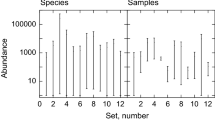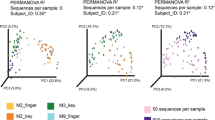Abstract
Taxon abundance patterns are a central focus in evolution and ecology, providing the basic architecture of natural assemblages and potential clues to their formative processes. To better interpret species abundance patterns in natural microbial communities, we examined the consequences of three fundamental types of abundance patterns—uniform, geometric, and lognormal distributions. Theoretical communities were constructed based on the three pattern types with 2000 to 20,000 species and 107 to 1010 individuals. The “dominant” species (species 1) among models that differed only in pattern type generally varied in abundance by 1 to 3 orders of magnitude. At the extremes among all the models examined, the dominant species comprised as much as 16% and as little as 0.005% of the total community. Analysis of the models and comparison with seven published surveys suggests that entire soil bacterial communities do not routinely exhibit Preston’s cannonical subset of lognormal distributions. Use of the models to evaluate survey limitations showed that common diversity indices are generally sensitive to sample size over the range (50 to 200 clones) commonly used for microbial communities, emphasizing the need to compare surveys of similar size. The results collectively demonstrate that uniform, geometric, and lognormal distributions have profoundly different experimental and ecological consequences. Further, defined abundance models provide a simple quantitative tool for evaluating abundance patterns in clone libraries (even small ones) from natural communities.





Similar content being viewed by others
References
G Bell (2000) ArticleTitleThe distribution of abundance in neutral communities. Am Naturalist 155 606–617 Occurrence Handle10.1086/303345
WH Berger FL Parker (1970) ArticleTitleDiversity of planktonic foraminifera in deep sea sediments. Science 168 1345–1347
R Bonnet A Suau J Dore GR Gibson MD Collins (2002) ArticleTitleDifferences in rDNA libraries of faecal bacteria derived from 10- and 25-cycle PCRs. Int J Syst Evolut Microbiol 52 757–763 Occurrence Handle10.1099/ijs.0.01755-0 Occurrence Handle1:CAS:528:DC%2BD38XkslCrsbo%3D
RJ Britten EH Davidsen (1983) ArticleTitle Hybridization strategy. . . .
TP Curtis WT Sloan JW Scannell (2002) ArticleTitleEstimating prokaryotic diversity and its limits. Proc Nat Acad Sci USA 99 10494–10499 Occurrence Handle10.1073/pnas.142680199 Occurrence Handle1:CAS:528:DC%2BD38Xmt1Chsrc%3D Occurrence Handle12097644
J Dunbar S Takala SM Barns JA Davis CR Kuske (1999) ArticleTitleLevels of bacterial community diversity in four arid soils compared by cultivation and 16S rRNA gene cloning. Appl Environ Microbiol 65 1662–1669 Occurrence Handle1:CAS:528:DyaK1MXitlartb8%3D Occurrence Handle10103265
J Dunbar SM Barns LO Ticknor CR Kuske (2002) ArticleTitleEmpirical and theoretical bacterial diversity in four Arizona soils. Appl Environ Microbiol 68 3035–3045 Occurrence Handle10.1128/AEM.68.6.3035-3045.2002 Occurrence Handle1:CAS:528:DC%2BD38XksVWqt7k%3D Occurrence Handle12039765
RT Espejo CG Feijoo J Romero M Vasquez (1998) ArticleTitlePAGE analysis of the heteroduplexes formed between PCR-amplified 16S rRNA genes: estimation of sequence similarity and rDNA complexity. Microbiology 144 1611–1617 Occurrence Handle1:CAS:528:DyaK1cXktVSntrk%3D Occurrence Handle9639932
V Farrelly FA Rainey E Stackebrandt (1995) ArticleTitleEffect of genome size and rrn gene copy number on PCR amplification of 16S rRNA genes from a mixture of bacterial species. Appl Environ Microbiol 61 2798–2801 Occurrence Handle1:CAS:528:DyaK2MXms1GrsLc%3D Occurrence Handle7618894
MM Fisher EW Triplett (1999) ArticleTitleAutomated approach for ribosomal intergenic spacer analysis of microbial diversity and its application to freshwater bacterial communities. Appl Environ Microbiol 65 4630–4636 Occurrence Handle1:CAS:528:DyaK1MXms1Oit7o%3D Occurrence Handle10508099
A Frostegård S Courtois V Ramisse S Clerc D Bernillon F LeGall P Jeannin X Nesme P Simonet (1999) ArticleTitleQuantification of bias related to the extraction of DNA directly from soils. Appl Environ Microbiol 65 5409–5420 Occurrence Handle10583997
KJ Gaston (1994) Rarity. Chapman and Hall London
MC Hansen T Tolker-Nielsen M Givskov S Molin (1990) ArticleTitleBiased 16S rDNA PCR amplification caused by interference from DNA flanking the template region. FEMS Microbiol Ecol 26 141–149 Occurrence Handle10.1016/S0168-6496(98)00031-2
J Harte (1999) ArticleTitleSelf-similarity in the distribution and abundance of species. Science 284 334–336 Occurrence Handle10.1126/science.284.5412.334 Occurrence Handle1:CAS:528:DyaK1MXitlOgtLY%3D Occurrence Handle10195901
W Liesack H Weyland E Stackebrandt (1991) ArticleTitlePotential risks of gene amplification by PCR as determined by SSU rDNA analysis of a mixed culture of strict barophilic bacteria. Microb Ecol 21 191–198 Occurrence Handle1:CAS:528:DyaK3MXmsV2msLs%3D
RM MacArthur (1960) ArticleTitleOn the relative abundance of species. Am Naturalist 94 25–36 Occurrence Handle10.1086/282106
AE Magurran (1998) Ecological Diversity and Its Measurement. Princeton University Press Princeton, NJ
F Martin-Laurent L Philippot S Hallet R Chaussod JC Germon G Soulas (2001) ArticleTitleDNA extraction from soils: old bias for new microbial diversity analysis methods. Appl Environ Microbiol 67 2354–2359 Occurrence Handle10.1128/AEM.67.5.2354-2359.2001 Occurrence Handle1:CAS:528:DC%2BD3MXjtlGmsLg%3D Occurrence Handle11319122
RM May (1975) Patterns of species abundance and diversity. JM Diamond (Eds) Ecology and Evolution of Communities Belnap Press Cambridge, MA 81–120
MF Polz CM Cavanaugh (1998) ArticleTitleBias in template-to-product ratios in multitemplate PCR. Appl Environ Microbiol 64 3724–3730 Occurrence Handle1:CAS:528:DyaK1cXms1entrc%3D Occurrence Handle9758791
FW Preston (1948) ArticleTitleThe commonness and rarity of species. Ecology 29 254–283
FW Preston (1962) ArticleTitleThe canonical distribution of commonness and rarity. Ecology 43 185–215
X Qiu L Wu H Huang PE McDonal AV Palumbo JM Tiedje JZ Zhou (2001) ArticleTitleEvaluation of PCR-generated chimeras, mutations, and heteroduplexes with 16S rRNA gene-based cloning. Appl Environ Microbiol 67 880–887 Occurrence Handle10.1128/AEM.67.2.880-887.2001 Occurrence Handle1:CAS:528:DC%2BD3MXhtFSltrk%3D Occurrence Handle11157258
A Reysenbach LH Giver GS Wickham NR Pace (1992) ArticleTitleDifferential amplification of rRNA genes by polymerase chain reaction. Appl Environ Microbiol 58 3417–3418 Occurrence Handle1:CAS:528:DyaK38XmsVKhs7k%3D Occurrence Handle1280061
C Shannon (1948) ArticleTitleA mathematical theory of communication. Bell Syst Tech J 27 379–423
EH Simpson (1949) ArticleTitleMeasurement of diversity. Nature 163 688
AGCL Specksnijder GA Kowalchuk S DeJong E Kline JR Stephen HJ Laanbroek (2001) ArticleTitleMicrovariation artifacts introduced by PCR and cloning of closely related 16S rRNA gene sequences. Appl Environ Microbiol 67 469–472 Occurrence Handle10.1128/AEM.67.1.469-472.2001 Occurrence Handle1:CAS:528:DC%2BD3MXjtVWktw%3D%3D Occurrence Handle11133483
M Suzuki MS Rappe SJ Giovannoni (1998) ArticleTitleKinetic bias in estimate of coastal picoplankton community structure obtained by measurements of small-subunit rRNA gene PCR amplicon length heterogeneity. Appl Environ Microbiol 64 4522–4529 Occurrence Handle1:CAS:528:DyaK1cXnt1WqsLg%3D Occurrence Handle9797317
MT Suzuki SJ Giovannoni (1996) ArticleTitleBias caused by template annealing in the amplification of mixtures of 16S rRNA genes by PCR. Appl Environ Microbiol 62 625–630 Occurrence Handle1:CAS:528:DyaK28XovVCrug%3D%3D Occurrence Handle8593063
M Tokeshi (1993) ArticleTitleSpecies abundance patterns and community structure. Adv Ecol Res 24 111–186
GC Wang Y Wang (1996) ArticleTitleThe frequency of chimeric molecules as a consequence of PCR co-amplification of 16S rRNA genes from different bacterial species. Microbiology 142 1101–1114
GC Wang Y Wang (1997) ArticleTitleFrequency of formation of chimeric molecules as a consequence of PCR coamplification of 16S rRNA genes from mixed bacterial genomes. Appl Environ Microbiol 63 4645–4650 Occurrence Handle1:CAS:528:DyaK2sXnvV2rsbw%3D Occurrence Handle9406382
KH Wilson RB Blitchington (1996) ArticleTitleHuman colonic biota studied by ribosomal DNA sequence analysis. Appl Environ Microbiol 62 2273–2278 Occurrence Handle1:CAS:528:DyaK28XjvFGntro%3D Occurrence Handle8779565
J Zhou B Xia DS Treves LY Wu TL Marsh RV O’Neill AV Palumbo JM Tiedje (2002) ArticleTitleSpatial and resource factors influencing high microbial diversity in soil. Appl Environ Microbiol 68 326–334 Occurrence Handle10.1128/AEM.68.1.326-334.2002 Occurrence Handle1:CAS:528:DC%2BD38Xjt1WmtQ%3D%3D Occurrence Handle11772642
Acknowledgements
This work was supported by a Lab-Directed Research and Development grant to J.M.D. from Los Alamos National Laboratory.
Author information
Authors and Affiliations
Corresponding author
Rights and permissions
About this article
Cite this article
Narang, R., Dunbar, J. Modeling Bacterial Species Abundance from Small Community Surveys . Microb Ecol 47, 396–406 (2004). https://doi.org/10.1007/s00248-003-1026-7
Received:
Accepted:
Published:
Issue Date:
DOI: https://doi.org/10.1007/s00248-003-1026-7




